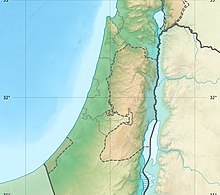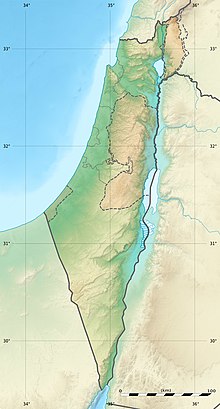Battle of Jericho
| Battle of Jericho (biblical) | |||||
|---|---|---|---|---|---|
Julius Schnoor von Carolsfeld (1794–1872) | |||||
| |||||
| Belligerents | |||||
| Israelites | Canaanites | ||||
| Commanders and leaders | |||||
| Joshua | King of Jericho † | ||||
| Strength | |||||
| 40,000[1] | Unknown | ||||
| Casualties and losses | |||||
| Nil | Massacre of all inhabitants (excluding Rahab and her family). | ||||
Location within West Bank | |||||
The Battle of Jericho, as described in the
Biblical account
According to the Book of Joshua, when the Israelites were encamped at Shittim opposite Jericho, ready to cross the river, Joshua, as a final preparation, sent out two spies to Jericho. The spies stayed in the house of Rahab, a local prostitute. The king of Jericho sent soldiers who asked Rahab to bring out the spies. Instead, she hid them under bundles of flax on the roof. After escaping, the spies promised to spare Rahab and her family after taking the city, if she would mark her house by hanging a red cord out the window.
After the Israelites crossed the Jordan, the king of Jericho ordered that the gates of the walls be closed. God commanded Joshua to go around the walls of Jericho for six days, once every day, and seven times on the seventh day. God commanded the city to be attacked by seven priests blowing horns, with the Ark of the Covenant in front of them and all the people behind the Ark of the Covenant. They encircled the wall of Jericho once a day for the first six days, and then encircled the city seven times on the seventh day. After the shofar (horn) sounded a great blow, the Israelites shouted, and the city walls fell beneath them.
Following God's law, the Israelites killed every man and woman of every age, as well as the oxen, sheep, and donkeys. Only Rahab, her parents, brothers and all "those who belonged to her" were spared. They were incorporated into Israel. Joshua then cursed anybody who rebuilt the foundations and gates, with the deaths of their firstborn and youngest child respectively. This was eventually fulfilled by Hiel the Bethelite under King Ahab's reign.
Origins and historicity

Excavations at Tell es-Sultan
In 1868,
More recently, Lorenzo Nigro from the Italian-Palestinian Expedition to Tell es-Sultan has argued that there was some sort of settlement at the site during the 14th and 13th centuries BCE.[9] He states that the expedition has detected Late Bronze II layers in several parts of the tell, although its top layers were heavily cut by levelling operations during the Iron Age, which explains the scarcity of 13th century materials.[10] Nigro says that the idea that the Biblical account should have a literal archaeological correspondence is erroneous, and "any attempt to seriously identify something on the ground with biblical personages and their acts" is hazardous.[11]
Historicity
The strong consensus among scholars is that the Book of Joshua holds little historical value.
Parallels with Sodom and Gomorrah
Ekaterina E. Kozlova sees parallels between Joshua 2 and Genesis 19, which narrates the fall of Sodom and Gomorrah. Like Sodom and Gomorrah, Jericho was presumed to be equally as wicked. However, there are some lone dissenters against Jericho's "oppressive establishment" such as Rahab, who sided with Jericho's destroyers (i.e. the Israelites). [19]
Coincidentally, these cities of Jericho and Sodom and Gomorrah were believed to lie among a major fault line extending 1,100 kilometers from the Red Sea to Turkey.[20]
See also
- Ai (Bible)
- Biblical archaeology
- "Joshua Fit the Battle of Jericho", African-American spiritual about the battle
References
- ^ Joshua 4:13
- ^ a b Jacobs 2000, p. 691.
- ^ a b Coote 2000, p. 275.
- ^ Dever 2006, p. 47.
- ^ Wagemakers 2014, pp. 122ff.
- ^ Wagemakers 2014, pp. 122–124.
- ^ a b Dever 2006, pp. 45–46.
- ^ a b Bruins & van der Plicht 1995, p. 213.
- ^ Nigro 2020, p. 202.
- ^ Nigro 2020, pp. 202–204.
- ^ Nigro 2020, p. 204.
- ISBN 978-0-300-09038-3.
- ^ "Hermitage Museum".
- ^ Gorelik, Michael (1979). "Oriental Armour of the Near and Middle East from the Eighth to the Fifteenth Centuries as Shown in Works of Art", by Michael Gorelik, in: Islamic Arms and Armour, ed. Robert Elgood, London 1979. Robert Elgood.
- ^ Killebrew 2005, p. 152.
- ^ Creach 2003, pp. 9–10.
- ^ Laffey 2007, p. 337.
- ^ Creach 2003, pp. 10–11.
- ^ Kozlova, Ekaterina E. (2020). "What is in a Name? Rahab, the Canaanite, and the Rhetoric of Liberation in the Hebrew Bible". Open Theology. 6 (1) – via De Gruyter.
- ISBN 978-0195090949.)
{{cite book}}: CS1 maint: date and year (link
Bibliography
- Bruins, Hendrik J.; van der Plicht, Johannes (1995). "Tell Es-Sultan (Jericho): Radiocarbon Results…" (PDF). Radiocarbon. 37 (2). Proceedings of the 15th International ¹⁴C Conference: 213–220. .
- Coote, Robert B. (2000). "Conquest: Biblical narrative". In Freedman, David Noel; Myers, Allen C. (eds.). Eerdmans Dictionary of the Bible. Eerdmans. ISBN 978-9053565032.
- Creach, Jerome F.D. (2003). Joshua. Westminster John Knox Press. ISBN 978-0664237387.
- Dever, William G. (2006). Who Were the Early Israelites and Where Did They Come From?. Eerdmans. ISBN 978-0802844163.
- Jacobs, Paul F. (2000). "Jericho". In Freedman, David Noel; Myers, Allen C. (eds.). Eerdmans Dictionary of the Bible. Eerdmans. ISBN 978-9053565032.
- Killebrew, Ann E. (2005). Biblical Peoples and Ethnicity: An Archaeological Study of Egyptians, Canaanites, and Early Israel, 1300–1100 B.C.E. Society of Biblical Literature. ISBN 978-1589830974.
- Laffey, Alice L. (2007). "Deuteronomistic history". In Espín, Orlando O.; Nickoloff, James B. (eds.). An introductory dictionary of theology and religious studies. Liturgical Press. ISBN 978-0814658567.
- Moore, Megan Bishop; Kelle, Brad E. (2011). Biblical History and Israel's Past. Eerdmans. ISBN 978-0802862600.
- Nigro, Lorenzo (2020). "The Italian-Palestinian Expedition to Tell es-Sultan, Ancient Jericho (1997–2015)". In Sparks, Rachel T.; Finlayson, Bill; Wagemakers, Bart; SJ, Josef Mario Briffa (eds.). Digging Up Jericho: Past, Present and Future. Archaeopress Publishing Ltd. ISBN 978-1789693522.
- Wagemakers, Bart (2014). Archaeology in the 'Land of Tells and Ruins': A History of Excavations in the Holy Land Inspired by the Photographs and Accounts of Leo Boer. Oxbow Books. ISBN 978-1782972464.
External links
 Media related to The Battle of Jericho at Wikimedia Commons
Media related to The Battle of Jericho at Wikimedia Commons



